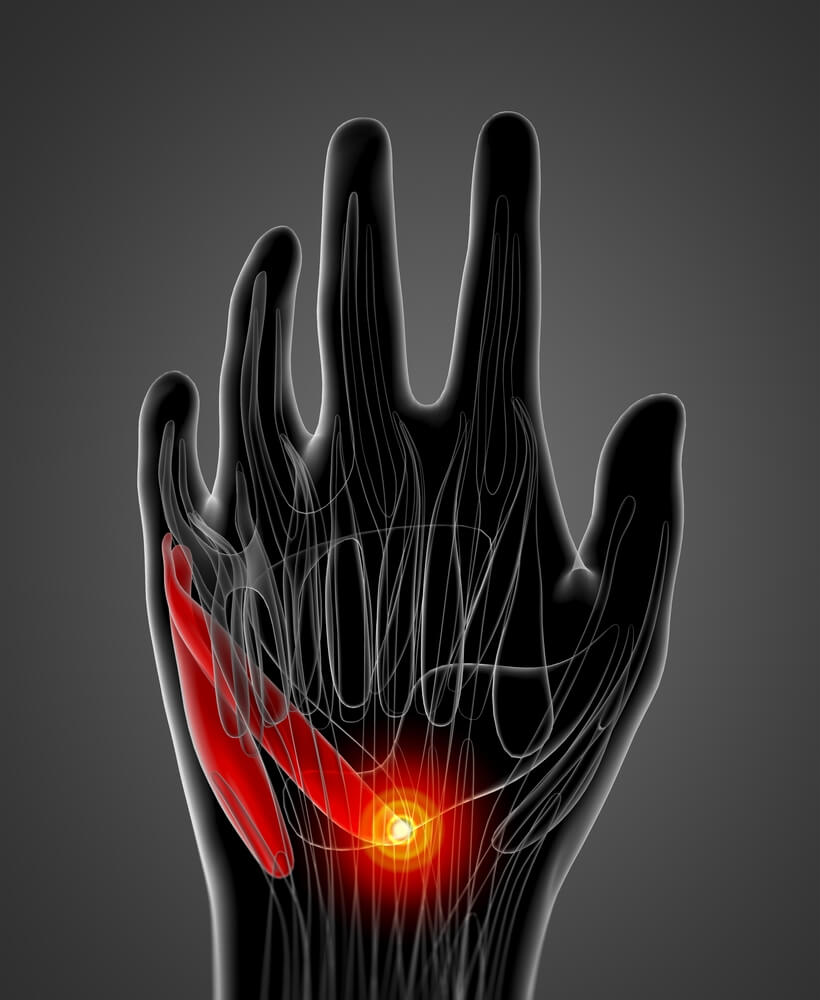The thenar eminence is an important part of the hand located at the base of the thumb. It consists of muscles that provide strength and stability to the thumb, allowing us to perform various activities such as gripping objects and writing.
However, when the thenar eminence becomes painful, it can significantly impact our daily lives. Thenar eminence pain, often resulting from overuse injuries, can be quite discomforting. Fortunately, there are various treatment options available, including splinting and simple home remedies such as applying ice and heat.
In this article, we will explore how to diagnose, treat, and prevent thenar eminence pain so you can regain control of your hand health.
Table of Contents
What is Thenar Eminence Pain?
Thenar eminence pain refers to discomfort and tenderness experienced in the area at the base of the thumb. A variety of factors, including overuse, repetitive strain injuries, and trauma can cause it. The pain can make it difficult to perform simple tasks such as holding a pen or opening a jar, affecting our productivity and overall quality of life.
Causes and Diagnosis
To effectively treat thenar eminence pain, it is crucial to identify its underlying causes. Common causes include repetitive hand movements, excessive gripping, and direct trauma to the area. Additionally, conditions like carpal tunnel syndrome and arthritis can also contribute to the development of thenar eminence pain.
If you suspect you may be experiencing thenar eminence pain, it is recommended to consult a medical professional. They will conduct a physical examination and evaluate your medical history to determine the exact cause of your pain. It is important to rule out other conditions that may present similar symptoms to ensure an accurate diagnosis.
Must Read: Major Signs and Causes of Heel Pain – Potential Tips to Avoid Them
Treatment Options
Once diagnosed, several treatment options are available to alleviate thenar eminence pain.
1. Rest and Self-Care
Resting the affected hand is essential to allow the damaged tissues to heal. Avoid activities that aggravate the pain, and consider using a splint or brace to provide support and reduce strain. Applying ice packs to the area can help reduce inflammation, while over-the-counter pain relievers can provide temporary relief. It is important to listen to your body and give it the rest it needs to recover.
2. Physical Therapy
Physical therapy plays a crucial role in the treatment of thenar eminence pain. A trained therapist can guide you through specific exercises and stretches designed to improve flexibility and strength in the affected area. These exercises may include thumb stretches, resistance training, and gentle massage techniques. Physical therapy can help reduce pain, restore function, and prevent future injuries.
3. Medications
In some cases, healthcare professionals may prescribe medications to manage thenar eminence pain. Nonsteroidal anti-inflammatory drugs (NSAIDs) are commonly used to reduce inflammation and alleviate discomfort. However, it is important to follow the prescribed dosage and consult with your healthcare provider for appropriate use.
4. Corticosteroid Injections
For more severe cases of thenar eminence pain, corticosteroid injections may be recommended. These injections deliver powerful anti-inflammatory medication directly to the affected area, providing temporary relief. It is crucial to have these injections administered by a healthcare professional, as they come with potential risks and limitations.
5. Surgical Intervention
Surgical intervention may be considered in rare cases where conservative treatments fail to provide relief. Surgical procedures aim to address underlying issues and alleviate chronic thenar eminence pain. However, surgery is typically seen as a last resort, and healthcare professionals will exhaust conservative treatment options before recommending it.
Home Remedies for Thenar Eminence Pain
In addition to medical treatments, some simple home remedies can help alleviate thenar eminence pain. These remedies can be used alongside other treatment options to provide additional relief. Here are some home remedies you can try:
- Warm Compress: Applying a warm compress to the affected area can help relax the muscles and reduce pain and inflammation. You can use a warm towel or a heating pad for this purpose. Remember to use a moderate temperature to avoid burning your skin.
- Epsom Salt Soak: Soaking your hand in warm water mixed with Epsom salt can help reduce pain and inflammation. Epsom salt contains magnesium sulfate, which can help relax muscles and relieve discomfort. Add a few tablespoons of Epsom salt to warm water and soak your hand for about 15-20 minutes.
- Gentle Massage: Gently massaging the thenar eminence can help increase blood flow and promote healing. Use your opposite hand to apply gentle pressure and circular motions to the area. Avoid applying too much pressure and discontinue if you experience any increase in pain.
- Stretching Exercises: Performing stretching exercises can help improve flexibility and reduce muscle tension in the hand. You can try simple exercises like making a fist and then slowly opening your hand or gently stretching your thumb in different directions. Consult with a physical therapist for specific exercises tailored to your condition.
- Topical Pain Relief: Over-the-counter creams or gels containing ingredients like menthol or capsaicin can provide temporary relief from thenar eminence pain. Apply a small amount to the affected area following the instructions on the product label.
It is important to note that home remedies may not provide complete relief on their own, especially for more severe cases. It is recommended to consult with a healthcare professional to ensure a proper diagnosis and appropriate treatment plan.

Preventing Thenar Eminence Pain
Prevention is always better than cure. By adopting healthy habits and making some small changes, you can reduce the risk of developing thenar eminence pain. Here are some preventive measures to consider:
- Take Frequent Breaks: If your work or activities involve repetitive hand movements, take regular breaks to rest your hands and give them time to recover.
- Maintain Proper Posture: Poor posture can strain the muscles in your hand and contribute to pain. Maintain good posture while sitting or standing, and avoid excessive bending or twisting of your wrist.
- Use Ergonomic Tools: When performing tasks that require gripping or using your hands extensively, opt for ergonomic tools or equipment that provide better support and minimize strain on your hand muscles.
- Practice Good Hand Hygiene: Frequent handwashing is essential for maintaining hand health and preventing the spread of infections. Use gentle soap and warm water, and pat your hands dry instead of rubbing them.
- Stay Active: Regular exercise and strengthening activities can help improve overall hand and wrist strength, reducing the risk of injuries and pain. Consult with a physical therapist for appropriate exercises and techniques.
- Listen to Your Body: Pay attention to any discomfort or pain in your thenar eminence area. If you notice any symptoms, take appropriate action, such as modifying your activities or seeking medical advice, to prevent the condition from worsening.
By implementing these preventive measures and making small lifestyle adjustments, you can reduce the likelihood of developing thenar eminence pain and maintain healthy hand function.
Who's at Risk for Thenar Eminence Pain?
While anyone can experience thenar eminence pain, certain individuals are more prone to developing this condition. Here are some groups of people who may be at higher risk:
- Occupations that involve frequent computer use or the use of hand tools, such as typing or carpentry.
- Individuals involved in activities that require repetitive hand movements, such as massage therapy, where continuous use of the hands can strain the thenar eminence.
- Athletes who participate in sports like hockey, baseball, and golf, which involve gripping objects tightly and putting stress on the thumb area.
- People who engage in hobbies or artistic pursuits that require repetitive hand movements, such as cooking, art, music (playing certain instruments), sewing, knitting, and writing for extended periods.
It's important to note that the abovementioned risk factors do not guarantee the development of thenar eminence pain. However, individuals involved in these activities should be mindful of proper hand positioning, take regular breaks, and practice hand exercises to minimize the risk of developing this condition.
Conclusion
Thenar eminence pain can be a frustrating and debilitating condition, but with the right diagnosis, treatment, and prevention strategies, you can regain control of your hand health. Remember to consult with a healthcare professional for an accurate diagnosis and to develop a personalized treatment plan.
By incorporating rest, self-care, physical therapy, and, if necessary, medications or surgical intervention, you can effectively manage thenar eminence pain. Additionally, practicing ergonomic techniques, engaging in strengthening and stretching exercises, and making workstation modifications can help prevent the onset of this condition altogether.
Take care of your hands and prioritize their health. By doing so, you can continue to perform daily activities easily and comfortably, ensuring a better quality of life.
Also Like: Danielle Rose Russell’s Inspiring Weight Loss Journey: Overcoming Body Shaming


